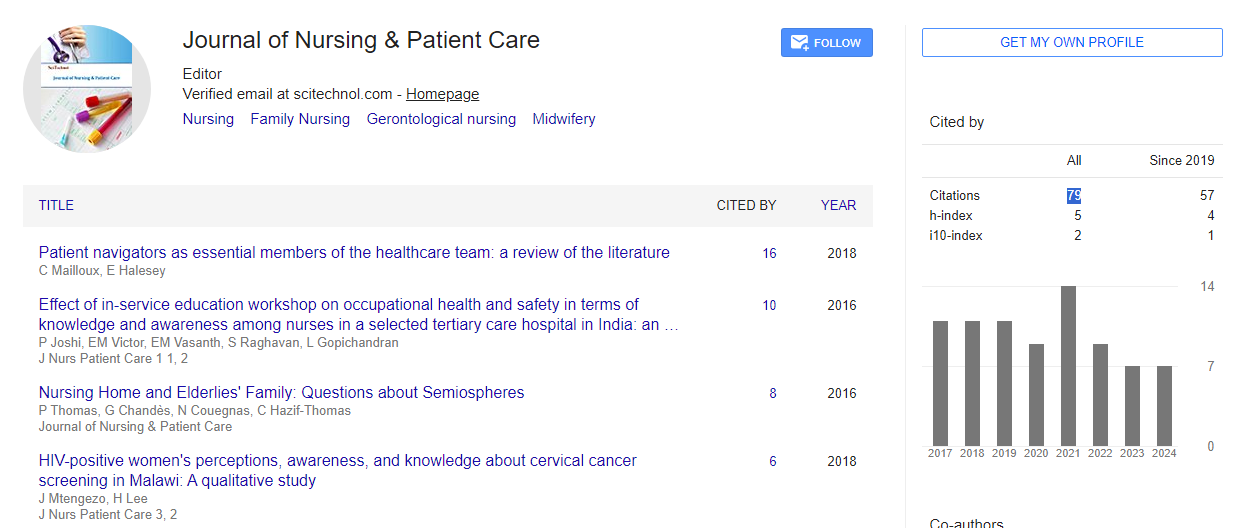Innovation in earlier identification of pediatric severe sepsis: Application of an electronic pediatric severe sepsis screening tool (E-assist study)
Samir H Shah
University of Tennessee Health Sciences Center, USA
: J Nurs Patient Care
Abstract
Background: Earlier recognition of pediatric Severe Sepsis (SS) is critical for timely goal-directed therapy and improving patient outcomes. Early indicators of SS and therapy administered in response to an Electronic Medical Record (EMR)- integrated, pediatric SS screening algorithm ('sniffer') have not been described. Methods: All adolescents (13-18 years) admitted to Le Bonheur Children's Hospital from over a 1-year period (n=3138) were screened using an EMR SS screening algorithm. Demographics, diagnoses, and interventions on all patients were collected for potential CRS cases. Results: Using mixed logistic regression on 15 alert indicators, pulse (p=0.004), temperature (p=0.008), ALT (p=0.015) and BUN/Creatinine ratio (p=0.013) were found to be key independent determinants of pediatric SS. Alert-mediated, early goaldirected therapies (administered within 6 hours of a positive alert) were fluid bolus (33%, n=12), antibiotic use (61%, n=44), and oxygen support (96%, n=55). The median time (hours) from the first positive alert to therapy was 9.4 - fluid bolus (IQR 3.1-68.9), 5.3 - antibiotic use (IQR 1.8-9.6), and 0.8 - oxygen support (IQR 0.4-1.6). True positive cases (n=66) had increases in hospital length of stay (LOS; in days) - 5.4 (p=0.004); ICU LOS - 8.5 (p<0.001); mechanical ventilator use - 3.3 (p=0.003); pressor support - 0.8 (p=0.17). SS mortality was 2.5% (n=5). Conclusions: An EMR-integrated SS real-time screening algorithm offers the potential to facilitate early goal-directed therapy and decrease sepsis-related mortality.
Biography
Samir H Shah MD, MBA is a pediatric critical care physician and researcher. He is a clinical expert in managing patients in the pediatric and cardiac critical care units. His clinical research focuses on the philosophy that a patient’s outcome can be improved by using predictive modeling, creating appropriate trigger alerts and team education. Dr. Shah is the Chief of Pediatric Critical Care Medicine at the University of Tennessee Health Sciences Center / Le Bonheur Children’s Hospital. He holds the position of Professor in the division of Pediatrics and he is the Fellowship Program Director of Pediatric Critical Care Medicine at UTHSC. Earlier, Dr. Shah was a faculty in Pediatric Critical Care and Emergency Medicine at the University of Manitoba, Canada. Dr. Shah received his MD at Seth G. S. Medical College and completed his training in Pediatric Surgery at Grant Medical College in India. He completed his Pediatric Critical Care Medicine training at UCLA – Harbor, CA and a fellowship in Pediatric Cardiac Critical Care at Children’s Hospital Los Angeles / USC. Dr. Shah received his Masters of Business Administration from the University of Tennessee. He has published more than 25 papers in reputed journals and has been serving as an editorial board member for journals related to Pediatric Critical Care.
 Spanish
Spanish  Chinese
Chinese  Russian
Russian  German
German  French
French  Japanese
Japanese  Portuguese
Portuguese  Hindi
Hindi 